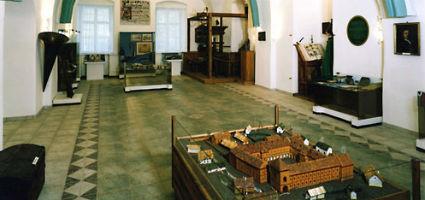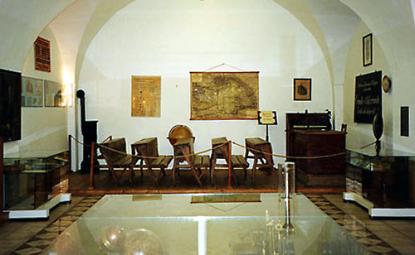2024. November 22. Friday
The Museum of the Reformed Collage of Debrecen - Debrecen
 |
Address: 4044, Debrecen Kálvin tér 16.
Phone number: (52) 516-856, (52) 516-857, (52) 516-923
E-mail: muzeum@silver.drk.hu
Opening hours: 11.04-31.05.: Closed
|
Museum tickets, service costs:
|
Ticket for adults
|
900 HUF
|
|
|
Individual ticket for adults
|
1300 HUF
|
|
|
Group ticket for adults
|
800 HUF
|
|
|
Ticket for students
|
500 HUF
|
|
|
Individual ticket for students
|
800 HUF
|
|
|
Ticket for pensioners
|
500 HUF
|
|
|
Ticket for families
(max. 2 adults + 4 children)
|
2000 HUF
|
/ family
|
|
Guide
|
3000 HUF
|
|
|
Guide
|
4000 HUF
|
|
|
Guide
|
4000 HUF
|
|
|
Guide
|
5000 HUF
|
|
|
Audio guide
|
500 HUF
|
|
|
Photography
|
200 HUF
|
|
|
Video
|
1600 HUF
|
The museum of the Calvinist College in Debrecen is a member institute of the Calvinist Ecclesiaestical Collection of the Trans-Tiszanian Region. After a history of several centuries and a public period in the 19th century it was given operational permit in 1964.

The museum serves as a regional and a College museum as well. The Debrecen College was established in 1538. This dual connection can be found in every sphere of its operation, whether it is the collection target or the permanent exhibitions.
At present nearly 17 000 objects are filed in the classes of ethnography, history, school history, fine arts and numismatics. The most significant collection is that of the applied arts collection keeping the unique treasures of the Hungarian goldsmith’s craft and embroydery. The gallery is enriched by the pictures of Sámuel Kiss, Bálint Kiss, Soma Orlay Petrics, Miklós Barabás, Mihály Zichy, József Rippl Rónai, and the copper engraving works of the students of Debrecen. Also, some statues and plastic works of István Ferenczi, Miklós Izsó and Ferenc Medgyessy are exhibited here.
Besides the Szőnyi collection that at one time consisted of 33 000 pieces, the meteor of Kaba is also a part of the mineral collection. The College kept a significant ethnography collection as early as around the 1840’ies. Items of this group were collected by teachers János Kovács (Nort Africa) and Lajos Bíró (New Guinea). The collection of this latter one at present is found at the Ethnographical Museum.
Traditions of collecting relics goes right back to the times of the establishment of the school. In the first inventories of the library lists can be found of the rare items such as coins, skeletons, mammoth teet, weapons, paintings etc. First mention of the Relics store was done in 1761. The museum supervised by Professor János Kovács could be visited each Sunday from the year of 1858. However, in 1896 this collection was moved back to the library. The thought of founding a museum occoured to Lajos Zoltai (Director of the Déri Museum) in 1916. Later Sándor Csikesz was keeping up this work. He wanted to exhibit most of the materials of the National Calvinist Collection.
Finally the Ministry of Culture gave the museum the operational permit in 1964. Director Béla Takács had done much work in order to collect and file the ecclesiastic art treasures of the Trans-Tiszanian region. The new permanent exhibitions of school history and ecclesiastical arts were arranged by Botond Gáborjáni Szabó in 1996 and in 2001.

The museum serves as a regional and a College museum as well. The Debrecen College was established in 1538. This dual connection can be found in every sphere of its operation, whether it is the collection target or the permanent exhibitions.
At present nearly 17 000 objects are filed in the classes of ethnography, history, school history, fine arts and numismatics. The most significant collection is that of the applied arts collection keeping the unique treasures of the Hungarian goldsmith’s craft and embroydery. The gallery is enriched by the pictures of Sámuel Kiss, Bálint Kiss, Soma Orlay Petrics, Miklós Barabás, Mihály Zichy, József Rippl Rónai, and the copper engraving works of the students of Debrecen. Also, some statues and plastic works of István Ferenczi, Miklós Izsó and Ferenc Medgyessy are exhibited here.
Besides the Szőnyi collection that at one time consisted of 33 000 pieces, the meteor of Kaba is also a part of the mineral collection. The College kept a significant ethnography collection as early as around the 1840’ies. Items of this group were collected by teachers János Kovács (Nort Africa) and Lajos Bíró (New Guinea). The collection of this latter one at present is found at the Ethnographical Museum.
Traditions of collecting relics goes right back to the times of the establishment of the school. In the first inventories of the library lists can be found of the rare items such as coins, skeletons, mammoth teet, weapons, paintings etc. First mention of the Relics store was done in 1761. The museum supervised by Professor János Kovács could be visited each Sunday from the year of 1858. However, in 1896 this collection was moved back to the library. The thought of founding a museum occoured to Lajos Zoltai (Director of the Déri Museum) in 1916. Later Sándor Csikesz was keeping up this work. He wanted to exhibit most of the materials of the National Calvinist Collection.
Finally the Ministry of Culture gave the museum the operational permit in 1964. Director Béla Takács had done much work in order to collect and file the ecclesiastic art treasures of the Trans-Tiszanian region. The new permanent exhibitions of school history and ecclesiastical arts were arranged by Botond Gáborjáni Szabó in 1996 and in 2001.
